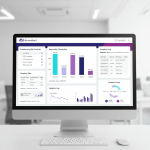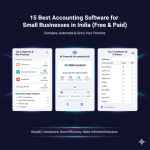Key takeaways
- Choose a bank statement parser AI India that handles real Indian conditions, mixed formats, noisy scans, bilingual layouts, and complex narrations with UPI, IMPS, NEFT, and GST references.
- Prioritize intelligent OCR banking over basic OCR, because it understands structure and context, not just characters.
- Insist on comprehensive statement data extraction, with UTRs, cheque numbers, payment modes, running balances, GST on charges, and reconciliation checkpoints.
- Evaluate transaction categorization AI for accuracy, learning from corrections, rule overrides, and Tally or Zoho Books integration.
- Check security and compliance rigor, ISO 27001, SOC 2 Type 2, encryption, audit logs, and India data residency options.
- Measure performance at scale, pages per minute, bulk runs during month end, API availability, and resilience under load.
- Demand transparent pricing and strong support SLAs, with rapid template updates when banks change formats.
- For Indian workflows, specialized tools such as AI Accountant deliver higher accuracy and faster reconciliation than generic OCR stacks.
Table of contents
What is Bank Statement Parser AI for India?
A bank statement parser AI India solution is a specialized system that extracts, interprets, and categorizes data from Indian bank statements across PDFs, scans, images, CSV, and Excel. It is built to automate reconciliation and ledger posting into Indian stacks such as Tally and Zoho Books, while handling India specific realities like UPI VPAs, IMPS, NEFT, bilingual layouts, GST on charges, and password protected e statements.
Midnight reconciliations, mixed files, skewed scans, stamps, and watermark noise are not exceptions in India, they are the norm, which is why a general OCR often collapses, and an intelligent parser thrives.
Why intelligent OCR banking beats basic OCR
Intelligent OCR banking understands context and structure. It tackles skewed or low resolution scans, multi column tables, stamp noise, watermarks, password protected statements, and bilingual layouts. It parses Indian style narrations with UPI VPAs, UTRs, cheque numbers, and branch identifiers, then maps them to the right fields for downstream accounting.
For additional perspective, see independent reviews from Parsio, Parseur, Docsumo, and Precisa.
The power of multi format parser technology
A multi format parser ingests everything your team receives, native PDFs, scans, CSV exports from net banking, Excel downloads, and mobile images. It normalizes across varying quality and structure so downstream steps stay consistent even when source formats change mid month.
From extraction to transaction categorization AI
Extraction lays the foundation, capturing dates, values, narrations, UTRs, cheque numbers, DR or CR, balances, fees, GST, and interest. This feeds transaction categorization AI that auto maps entries to ledgers, vendors, GST codes, and payment modes, learning from reviewer corrections over time. Explore deeper narration parsing depth for Indian statements.
Further reading from neutral sources, Parsio, Parseur, Docsumo, Precisa.
Your evaluation checklist for Bank Statement Parser AI India
Coverage and format support
Confirm bank and format coverage for SBI, HDFC, ICICI, Axis, Kotak, Yes Bank, and PSU banks. Validate support for credit cards, current and savings accounts, and formats including PDFs, CSV, Excel, images, password protected statements, and bilingual layouts. Independent roundups, Parsio, Parseur, Docsumo, Precisa.
Intelligent OCR banking quality metrics
- Accuracy on tough scans, low resolution, skewed pages, multi column tables.
- Narration parsing depth, UPI VPAs, UTR for IMPS or NEFT, cheque numbers, branch codes, POS terminal names.
- Confidence scoring and human in the loop, scores per field, auto retries for low confidence, and reviewer queues.
See evaluations by Parseur and Docsumo.
Statement data extraction completeness
- Transaction date and value date, complete narration, UTRs, references, cheque numbers, payment mode.
- Debit or credit amounts, running balance, fees and charges, GST components, interest, forex fees and rates.
- Reconciliation checkpoints, duplicate detection, anomaly flags.
Transaction categorization AI capabilities
- Auto classification accuracy, ledgers, vendors, GST codes, payment modes, transfers or contra detection.
- Learning and overrides, firm level and client level models, rule engines, exception rules.
- Integration intelligence, link to invoices or bills in Tally or Zoho, maker checker workflows.
Industry views, Docsumo, Parsio, Precisa.
Integration and automation features
Expect one click sync and API based bi directional integration with Tally and Zoho Books, reconciliation status tracking, clear approvals, and exception handling. References, Parsio, Precisa.
Scale and performance benchmarks
Measure pages per minute, batch throughput, stability during month end spikes, and availability of APIs for custom flows. Sources, Parsio, Parseur.
Security and compliance standards
- ISO 27001, SOC 2 Type 2, encryption, audit logs.
- Granular access controls, India data residency options, frequent security updates.
See security checklists from Parsio, Parseur, Precisa.
Support and continuity assurance
Verify SLAs, dedicated CA support, sandbox access, and speed of new template rollout as banks alter layouts.
Pricing model transparency
Understand per page versus per statement versus per entity, support fees, API costs, and overage charges. Avoid hidden costs that dilute ROI. Background, Parsio.
Top Bank Statement Parser AI tools for Indian markets
- AI Accountant, purpose built for Indian workflows, native Tally or Zoho sync, GST aware mapping, and specialized NLP for Indian banks, often reducing manual classification by up to seventy five percent.
- QuickBooks, bank feeds and basic categorization, Indian support varies, limited on scanned OCR.
- Xero, reliable bank reconciliation, may struggle with Indian narrations and GST needs.
- Zoho Books, strong Indian coverage, OCR for scans may need add ons.
- FreshBooks, simple reconciliation, limited Indian bank coverage and OCR.
Comparing different approaches to bank statement processing
- Generic OCR and scripts, low cost and flexible, but weak on messy scans and Indian narration patterns.
- CSV exports only, clean when available, but misses scans, legacy PDFs, and format variations.
- Account Aggregator feeds, direct feeds and real time data, but not all banks or histories, OCR still needed for documents.
- Enterprise OCR suites, solid accuracy and scale, but expensive and not India specific by default.
- Specialized bank statement parser AI India, end to end India coverage with learning AI, requires template upkeep and a focused rollout.
Step by step workflow, how Bank Statement Parser AI India works
Step 1, ingestion through multi format parser
Drag and drop files or call APIs, the multi format parser accepts PDFs, CSV, Excel, and images, including password protected statements.
Step 2, intelligent OCR banking processing
Intelligent OCR banking detects tables, parses narrations, and assigns confidence to every field, handling skew, stamps, and watermark noise. Independent explainers, Parsio, Parseur, Docsumo.
Step 3, statement data extraction
Normalize fields, reconcile running balances, spot duplicates, and flag anomalies for reviewer attention.
Step 4, transaction categorization AI in action
Map to ledgers, vendors, GST codes, and payment modes, detect transfers or contra, and improve via reviewer corrections, steadily increasing automation.
Step 5, sync to accounting systems
One click or API sync to Tally and Zoho Books, fetch invoices and bills, then reconcile automatically.
Step 6, dashboards and exceptions
Track cash flow, unusual transactions, unresolved items, and approvals through automated dashboards. See analysis from Precisa.
India specific scenarios that prove solution fit
- UPI heavy MSME operations, parse high volume UPI VPAs, wallet refunds, mixed modes in single days.
- PSU bank scan challenges, stamps and signatures are common, the engine must thrive on noisy layouts with bilingual text.
- Credit card statements, extract EMI schedules, GST on fees, forex charges and conversion rates, and link to expenses.
- Inter company and contra entries, detect cross account transfers and split transactions cleanly.
- Month rollover checks, detect missing pages and continuity breaks via balance reconciliation.
Measurable outcomes and ROI from Bank Statement Parser AI India
Firms report up to seventy five percent reduction in manual classification per thousand transactions, month end closes compress from days to hours, and reviewer workloads shift to exceptions. Typical adoption metrics include more than one hundred eighty customers, more than fifty CA firms onboarded, more than three hundred million transactions processed, and thirty percent month on month growth in volumes. Security assurance comes from ISO 27001 and SOC 2 Type 2 certifications. Evidence and perspectives, Parsio, Precisa.
Implementation guide, from POC to full rollout
Pilot phase strategy
Start with two or three banks and a small set of entities, track extraction accuracy, categorization precision, and reconciliation success, iterate quickly.
Workflow configuration
Enable maker checker approvals, define exception rules, and set confidence thresholds for auto versus manual review.
Team training
Train reviewers on verification screens and keyboard driven corrections, because every correction improves the learning model.
Security and legal setup
Sign data processing agreements, review SOC 2 and ISO documents, define retention and access controls aligned with regulatory needs.
Risk management and mitigation strategies
Poor scan quality fallback
Request native PDFs or higher DPI rescans when confidence stays low, maintain a manual capture lane for true exceptions.
Accuracy safeguards
Use field level confidence thresholds and mandatory human review for sensitive fields like UTRs and cheque numbers, preserve complete audit trails.
Missing transaction detection
Automate balance reconciliation across page breaks and periods, flag gaps for investigation before export to books.
Key terminology for Indian banking workflows
- UTR, unique transaction reference for IMPS or NEFT, essential for reconciliation.
- VPA, virtual payment address used in UPI flows, appears in narrations.
- IMPS, NEFT, RTGS, Indian payment rails with distinct narration patterns.
- Contra entry, transfers between accounts of the same entity.
- Maker checker, two person approval standard in Indian accounting teams.
Making your decision, next steps
List your banks, formats, and volumes, shortlist solutions, then run a time bound POC using your real statements. Request checklists, test datasets, and security certifications. Validate posting quality into Tally or Zoho, confirm reconciliation speeds, and model costs under peak volumes. Remember, the goal is intelligent automation that understands Indian banking, not just text extraction.
Related reading on AI Accountant, How This Bank Statement OCR Tool Transforms PDFs Instantly, Automated Statement Reconciliation in India, Intercompany automation and eliminations, AI Accountant vs. Human Accountant.
The path forward for Indian financial automation
Specialized bank statement parser AI India solutions release accountants from repetitive reconciliation, enabling advisory and analysis. CA firms can scale to many clients without linear hiring, and SMB controllers gain faster visibility and fewer errors. The gap between firms using intelligent automation and those relying on manual effort will widen, so the right time to adopt is now.
FAQ
As a CA, how do I evaluate intelligent OCR banking accuracy on messy SBI or HDFC scans?
Run a controlled POC with a mix of skewed pages, stamps, bilingual content, and low DPI images. Track field level accuracy and confidence scores for UTRs, cheque numbers, amounts, and balances. A tool like AI Accountant provides confidence thresholds and reviewer queues so you can quantify where human checks are still required.
What is the minimum set of fields I should demand in statement data extraction for audit ready books?
Demand transaction date and value date, full narration, UTRs, cheque numbers, DR or CR, running balance, charges and GST components, interest credits or debits, and a reconciliation checksum per page. AI Accountant captures these and flags duplicates or anomalies before posting.
How does transaction categorization AI learn firm specific mapping rules for Tally ledgers?
Good systems learn from reviewer corrections and allow explicit rules. In AI Accountant, you can define vendor or VPA patterns, GST codes, and payment modes, with overrides at firm level and client level, so recurring patterns auto classify over time.
Can I rely only on Account Aggregator feeds or do I still need OCR for Indian banks?
Use Aggregator feeds for live data where banks are supported, but retain OCR for historical PDFs, unsupported banks, and scanned archives. Many CA firms run a hybrid, feeds for current months, OCR for backlog and exceptions. AI Accountant supports both.
How do I validate narration parsing depth for UPI VPAs and IMPS or NEFT UTRs?
Prepare a test set with varied narrations, UPI collect and pay, refunds, POS and ATM, and inter account transfers. Verify that the engine extracts standardized VPA, UTR, and instrument type fields. AI Accountant exposes extracted sub fields so you can compare against ground truth quickly.
What controls should a CA implement for maker checker during automated bank posting?
Define confidence thresholds above which auto posting is allowed, route low confidence items to a checker, and enforce dual approval on high risk categories such as large cash withdrawals. AI Accountant includes maker checker queues and an audit trail for every approval.
How does the system handle password protected PDF statements from ICICI or Axis?
The ingestion step should accept the password at upload or via API, unlock the file, and log access in the audit trail. AI Accountant supports password prompts and preserves a non reversible log for compliance reviews.
Is SOC 2 Type 2 and ISO 27001 mandatory for handling client bank statements in India?
While not legally mandated for all firms, these standards are best practice for financial data. They ensure access controls, encryption, change management, and monitoring. Choose vendors like AI Accountant that provide SOC 2 or ISO evidence, plus India data residency options if needed.
How do I detect missing pages or transactions when clients send partial PDFs?
Insist on balance continuity checks across pages and periods. The engine should compute running balance deltas and flag breaks. AI Accountant raises continuity exceptions so you can request the missing pages early.
How quickly can I move from POC to production across fifty clients and multiple banks?
With a structured rollout, two to four weeks is typical, start with two or three banks, validate mappings, train reviewers, and template updates follow via SLA. AI Accountant offers sandbox tenants and guided onboarding for CA firms scaling across many entities.
What is the best way to post GST on bank charges to the right ledgers automatically?
Use categorization rules that split the charge and GST components, then map to expense and input tax ledgers. AI Accountant identifies GST lines in narrations and applies GST aware mapping into Tally or Zoho Books.
Can the AI detect contra entries between current accounts and credit card payments?
Yes, by matching dates, amounts, and narrations across accounts, the engine flags probable inter account transfers. AI Accountant auto suggests contra mappings and prevents double counting during reconciliation.
How do I measure ROI, especially during month end crunch?
Track manual minutes per one hundred transactions before and after, percentage auto classification, reviewer rework rate, and time to reconcile. Firms using AI Accountant typically see up to seventy five percent reduction in manual classification, and faster month end closure.
What happens when a bank changes its statement template suddenly?
Your vendor should deliver rapid template updates under SLA, plus fallback extraction with human review. AI Accountant ships frequent template refreshes and flags low confidence items so your team stays in control.




